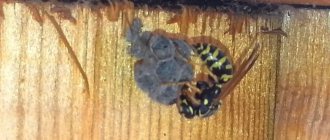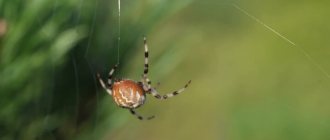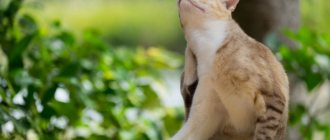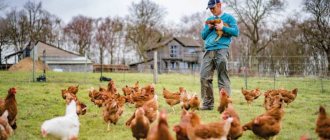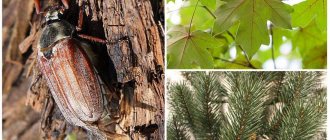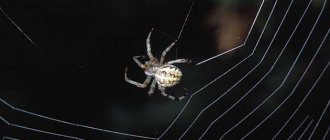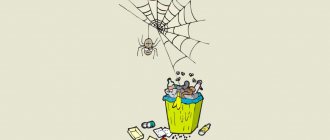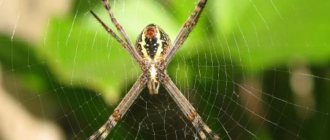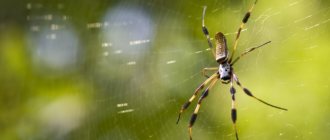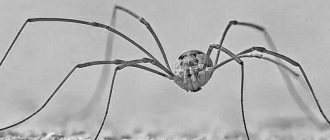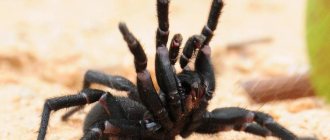We have all observed a situation when a fly, caught in a web, cannot get out of it, desperately twitches and becomes even more entangled in it. Meanwhile, the spider quickly runs towards its victim, not worrying at all about the sticky properties of the web.
How does this happen? Why does a fly stick tightly to the web, but the spider turns out to be invulnerable?
Surprisingly, this question was of interest not only to ordinary people and inquisitive children, but also to scientists. Since the beginning of the last century, they have been struggling with this riddle, and finally solved it.
There are several reasons for this phenomenon:
- not all threads in a web are sticky,
- Spiders have hairs on their legs and a special chemical
- Spiders move in a special way and carefully look after themselves.
What is a web and where does a spider get it from?
The abdominal cavity of the named insect contains up to 550 glands (microtubes) that produce future building material.
These spinning machines are ungrouped into 6 “warts”. This is a real mini adhesive rope factory. The nascent substance is a concentrated protein that quickly cools in air and hardens to the state of a thin thread that can withstand any gust of wind. The process already occurs inside each of the 6 warts - so the finished product flies out. The “hook-legged” one simply presses the warts to the point where he intends to start his weaving (as a rule, this is the corner of 3 planes). Warts are mobile - their functions resemble tentacles.
The structure will not crumble under the influence of a normal draft. The viscous substance is very similar in chemical composition to the tissue of silkworms. That is, the characteristics resemble silk. Only much more reliable and flexible. Caterpillar silk has a breaking load of 33-43 kilograms per 1 square meter. mm. And the product of a spider is from 40 to 261 kilograms per square meter. mm (here it all depends on the type of spider, and also on the location in which the designated “lace” is woven).
Where does a spider get its web in the form we are usually used to seeing it? That's another question.
How is a web weaved?
The basis of each spider trap is 3-4 load-bearing threads. This is the strongest part of the web. Radial threads are attached to the base, each end of which is attached to a support in the form of a tree branch, plant leaves, and so on. The spider applies a trapping spiral to the radial threads, which is the stickiest part of the trap. It is precisely this that spiders fall prey to—to prevent the prey from freeing itself, the predator quickly runs to it and injects poison. These substances transform the insides of insects caught in the web into a nutrient mass, which the spiders simply absorb into themselves.
The structure of the web
How does a spider weave its web?
The first portion of the released secretion is firmly glued to the selected location. Having thus fixed the beginning of the net being made, the insect gives another call to the system. The threads continue to stretch. How? The viscous substance is pushed through by the hind legs.
Before starting weaving, the spider chooses a place with a comfortable microclimate. It should be dry here, but not sunny. Cool, but not frosty. And, of course, there should be no wind.
When a multi-legged “micro-beast” leaves another location, the threads simply pull out after him (we have already said that they instantly harden in the open air). It moves in such a way that the network is a spiral composition intersected by radii. Where they converge is where the “start” was located. Sizes are usually different. Just like the nature of the spirals. In some places these are not even spirals, but circles of different diameters “inserted into each other.”
But in the forest, spiders build much larger “structures.” Have you noticed how in more often the sought-after “fetters” are stretched across the path? They are attached to tree trunks standing on opposite sides of the pole. Insects achieve this in this way. They produce a very long thread. Under the right circumstances, the breeze picks up the “rope”, mounting it on the branches of the nearest tree. And then it gets more interesting. Having walked to the middle of the “installation” (base) thread, the “multipede” weaves another one. This time hanging freely. Then the cunning man moves to its center, and, hanging vertically down, releases the next one. Until it reaches a nearby support. Using the method shown, a base for the frame is obtained. It's shaped like the letter Y. Now comes the most interesting part. “Tkach” connects the network intersection point with several more radius lines (more sticky). Until you get a lot of spirals. Different webs take different amounts of time - from 30 minutes to 2 hours.
It’s worth knowing that cross makers always have the same design for such a work – a spiral intersected by radii. But for any exotic spiders it can be anything. For example, the inhabitants of the Amazon weave several leaves into their masterpiece, creating decorations that attract flies.
RIDDLES OF THE WEB
Science and life // Illustrations
The adhesive substance covering the thread of the catching spiral is evenly distributed throughout the web in the form of bead droplets. The picture shows the place where two fragments of the catcher spiral are attached to the radius.
Science and life // Illustrations
Science and life // Illustrations
Science and life // Illustrations
Science and life // Illustrations
The initial stages of building a catching net by a cross spider.
The logarithmic spiral approximately describes the shape of the auxiliary spiral thread that the spider lays when constructing a wheel-shaped catching net.
The Archimedes spiral describes the shape of the adhesive trapping thread.
Zigzag threads are one of the features of the webs of spiders of the genus Argiope.
The crystalline regions of the silk fiber have a folded structure similar to the one shown in the figure. The individual chains are connected by hydrogen bonds.
Young cross spiders that have just emerged from their web cocoon.
Spiders of the family Dinopidae spinosa weave a web between their legs and then throw it over their prey.
The cross spider (Araneus diadematus) is known for its ability to weave large, wheel-shaped trapping webs.
Some types of spiders also attach a long “ladder” to the round trap, which significantly increases the efficiency of hunting.
Science and life // Illustrations
This is what the spider tubes from which the threads of spider silk emerge look like under a microscope.
‹
›
Spiders may not be the most attractive creatures, but their creation, the web, is nothing short of awe-inspiring. Remember how the geometric regularity of the finest threads shimmering in the sun, stretched between the branches of a bush or among tall grass, captivates the eye.
Spiders are one of the oldest inhabitants of our planet, inhabiting land more than 200 million years ago. There are about 35 thousand species of spiders in nature. These eight-legged creatures, which live everywhere, are recognizable always and everywhere, despite differences in color and size. But their most important distinguishing feature is their ability to produce spider silk, a natural fiber unsurpassed in strength.
Spiders use webs for a variety of purposes. They make cocoons for eggs from it, build shelters for wintering, use it as a “safety rope” when jumping, weave intricate trapping nets and wrap up caught prey. A female ready for mating produces a web thread marked with pheromones, thanks to which the male, moving along the thread, easily finds a partner. Young spiders of some species fly away from the parental nest on long threads carried by the wind.
Spiders feed mainly on insects. The hunting devices they use to get food come in a variety of shapes and types. Some spiders simply stretch out several signal threads near their shelter and, as soon as an insect touches the thread, they rush at it from ambush. Others throw a thread with a sticky drop at the end forward, like a kind of lasso. But the pinnacle of spiders’ design activity is still round wheel-shaped nets, located horizontally or vertically.
To build a wheel-shaped catching net, the cross spider, a common inhabitant of our forests and gardens, produces a fairly long, strong thread. A breeze or rising air flow lifts the thread upward, and, if the place for building the web is chosen well, it clings to the nearest branch or other support. The spider crawls along it to secure the end, sometimes laying another thread for strength. Then he releases a freely hanging thread and attaches a third to its middle, so that a Y-shaped structure is obtained - the first three radii out of more than fifty. When the radial threads and frame are ready, the spider returns to the center and begins to lay out a temporary auxiliary spiral - something like “scaffolding”. The auxiliary spiral holds the structure together and serves as a path for the spider when constructing a catching spiral. The entire main frame of the net, including the radii, is made of non-adhesive thread, but for the catcher spiral, a double thread coated with an adhesive substance is used.
What's surprising is that these two spirals have different geometric shapes. The temporary spiral has relatively few turns, and the distance between them increases with each turn. This happens because, when laying it, the spider moves at the same angle to the radii. The shape of the resulting broken line is close to the so-called logarithmic spiral.
The sticky trapping spiral is built according to a different principle. The spider starts at the edge and moves towards the center, keeping the same distance between the turns, creating an Archimedes spiral. At the same time, it bites off the threads of the auxiliary spiral.
Spider silk is produced by special glands located in the back of the spider's abdomen. There are at least seven types of arachnoid glands known to produce different threads, but no known spider species has all seven types at once. Usually a spider has from one to four pairs of these glands. Weaving a web is not a quick task, and it takes about half an hour to build a medium-sized trapping net. To switch to the production of a different type of web (for the catching spiral), the spider needs a minute's respite. Spiders often reuse webs by eating leftover webs that have been damaged by rain, wind, or insects. The web is digested in their body with the help of special enzymes.
The structure of spider silk has been perfectly developed over hundreds of millions of years of evolution. This natural material combines two wonderful properties - strength and elasticity. A web made of cobwebs can stop an insect flying at full speed. The thread from which spiders weave the base of their hunting web is thinner than a human hair, and its specific (that is, calculated per unit mass) tensile strength is higher than that of steel. If you compare spider thread with steel wire of the same diameter, they will support approximately the same weight. But spider silk is six times lighter, which means six times stronger.
Like human hair, sheep wool, and silk from silkworm cocoons, spider webs are composed primarily of proteins. In terms of amino acid composition, the proteins of the spider web - spidroins - are relatively close to fibroins, the proteins that make up the silk produced by silkworm caterpillars. Both contain unusually high amounts of the amino acids alanine (25%) and glycine (about 40%). Areas of protein molecules rich in alanine form crystalline regions densely packed into folds, providing high strength, and those areas where there is more glycine represent a more amorphous material that can stretch well and thereby impart elasticity to the thread.
How is such a thread formed? There is no complete and clear answer to this question yet. The process of web spinning has been studied in most detail using the example of the ampullaid gland of the orb-weaving spider Nephila clavipes. The ampullaid gland, which produces the strongest silk, consists of three main sections: a central sac, a very long curved canal, and a tube with an outlet. From the cells on the inner surface of the sac emerge small spherical droplets containing two types of spidroin protein molecules. This viscous solution flows into the tail of the sac, where other cells secrete another type of protein - glycoproteins. Thanks to glycoproteins, the resulting fiber acquires a liquid crystalline structure. Liquid crystals are remarkable in that, on the one hand, they have a high degree of order, and on the other, they retain fluidity. As the thick mass moves towards the outlet, the long protein molecules are oriented and aligned parallel to each other in the direction of the axis of the forming fiber. In this case, intermolecular hydrogen bonds are formed between them.
Humanity has copied many of nature's design discoveries, but such a complex process as spinning a web has not yet been reproduced. Scientists are now trying to solve this difficult problem using biotechnological techniques. The first step was to isolate the genes responsible for the production of the proteins that make up the web. These genes were introduced into the cells of bacteria and yeast (see Science and Life No. 2, 2001). Canadian geneticists have gone even further - they have bred genetically modified goats whose milk contains dissolved spider web proteins. But the problem is not only in obtaining spider silk protein, it is necessary to simulate the natural spinning process. But scientists have yet to learn this lesson from nature.
Purpose of the web
You already know how a spider makes its web. But why does she need a topic? For several purposes at once.
- Here the insect takes refuge from any enemy or from bad weather (it entwines a hole with a net).
- From the web, the creature makes nets to catch small flying creatures (flies, etc.).
- Cocoons for protecting eggs (their “cases”) are also made from durable “silk”.
- The web “mat” insures its owner at the moment of a long jump - the spider does not fall.
- The product is used as a container - in it the hunter sometimes drags large prey into a hole.
- A cradle for baby spiders is another purpose for a masterpiece of spinning craftsmanship.
- The cubs, ready for independent life, are sent along “ropes” to different corners.
- The adhesive substance prevents tarantulas from slipping.
- Sperm transfer.
It remains to add: for catching nets, a more sticky composition of the cobweb substance is used. Although not only the described insects, but all arachnids can prepare webs, only spiders secrete so much sticky substance that they can cover an entire small room with it.
Differences in webs by spider species
Depending on the species, spiders can weave different webs, which are a kind of “calling card” of the arthropod.
Round web
This version of the web looks incredibly beautiful, but is a deadly design. As a rule, a round web is suspended in a vertical position and has part of the adhesive threads, which does not allow the insect to escape from it. Weaving such a network is carried out in a certain sequence. At the first stage, the outer frame is made, after which radial fibers are laid from the central part to the edges. Spiral threads are woven at the very end.
This is interesting! A medium-sized circular web has more than a thousand point connections, and its production requires more than twenty meters of spider silk, which makes the structure not only very light, but also incredibly durable.
Information about the presence of prey in such a trap comes to the “hunter” through specially woven signal threads. The appearance of any breaks in such a web forces the spider to weave a new web. Old webs tend to be eaten by arthropods .
Strong web
This type of web is characteristic of nephilous spiders, which are widespread in Southeast Asia. The trapping nets they build often reach a couple of meters in diameter, and their strength allows them to easily support the weight of an adult.
Such spiders catch in their strong web not only ordinary insects, but also some small birds. Research results show that spiders of this type can produce about three hundred meters of spider silk daily.
Spider web hammock
Small, round “coin spiders” weave one of the most complex web designs. These arthropods weave flat webs on which the spider sits and waits for its prey. Special vertical threads extend up and down from the main network, which are attached to nearby vegetation . Any flying insects quickly become entangled in the vertically woven threads, after which they fall onto the flat hammock web.
Why doesn't the spider stick to the web?
If the substance described is so sticky, then why doesn’t its creator himself stick to the creation?
One important fact has already been mentioned. Threads are produced in 2 categories at once - dry (not sticky) and viscous (sticky). The creator of the web moves precisely along the first ones. Just like his offspring.
And if we are talking about the construction of the network itself (during the process all the threads must be glued together), then everything is clear here too. The spider secretes glue on its special legs. He smears it on the section of thread he walked over. The spider remembers everything.
Moreover, a substance is also released that, during movement, reduces the adhesion of the adhesive type of legs to the thread. To prevent these special legs from sticking to one of them.
Thus, it is clear that the spider is a combination consisting of three types of secretion at once. Different pairs of legs work with the glands. Some processes destroy an object in order to make a hole (the spider drags the victim there). The processes presented are controlled by the nerve center.
Reason one - not all threads in the web are sticky
Spiders spin different threads for different purposes . Some are for unhindered movement along the web, others are for catching and entangling insects, and still others are for weaving egg sacs. There are up to 6 different types of threads that spiders can weave.
The center of the web is woven from dry, safe threads. There the spider rests and patiently waits for its dinner. The radial threads running from the center to the edge and the outer circumference of the web itself are also made of dry threads. These are the paths along which the spider moves. But the circular threads are just sticky . They are the ones who hold the victim in a stranglehold and do not allow her to escape.
There are also webs where there are no completely sticky threads, they are simply dotted with small sticky droplets. The result is the same - the insect touches them and gets stuck, and the spider knows where to step and where not to.
Composition of the web
The basis of the web (2/3 of its composition) is the water-insoluble protein fibroin (fibrillar protein). This is a substance that gives spider webs increased strength. It consists of a complex of simple proteins (albumin), d-alanine (amino acid), glutamic and aminoacetic acids.
The stickiness of the web is provided by sericin (a substance of protein origin, silk glue). The chemical composition of the web also includes potassium nitrate and hydrogen phosphate, which provide protection against bacteria and fungi.
Depending on the type of glands used, the spider produces about 7 types of fibers of different chemical compositions, from which it weaves the structural parts of the web.
The structure of the thread is heterogeneous. It is composed of rigid protein crystals firmly connected by elastic ligaments. In terms of its chemical composition and properties, the web is similar to silkworm silk, but spider silk is stronger.
The thread retains tensile strength and does not twist even with prolonged rotation. The last property is called “hinge”. Sunlight, hot and dry air weaken the strength of the thread.
